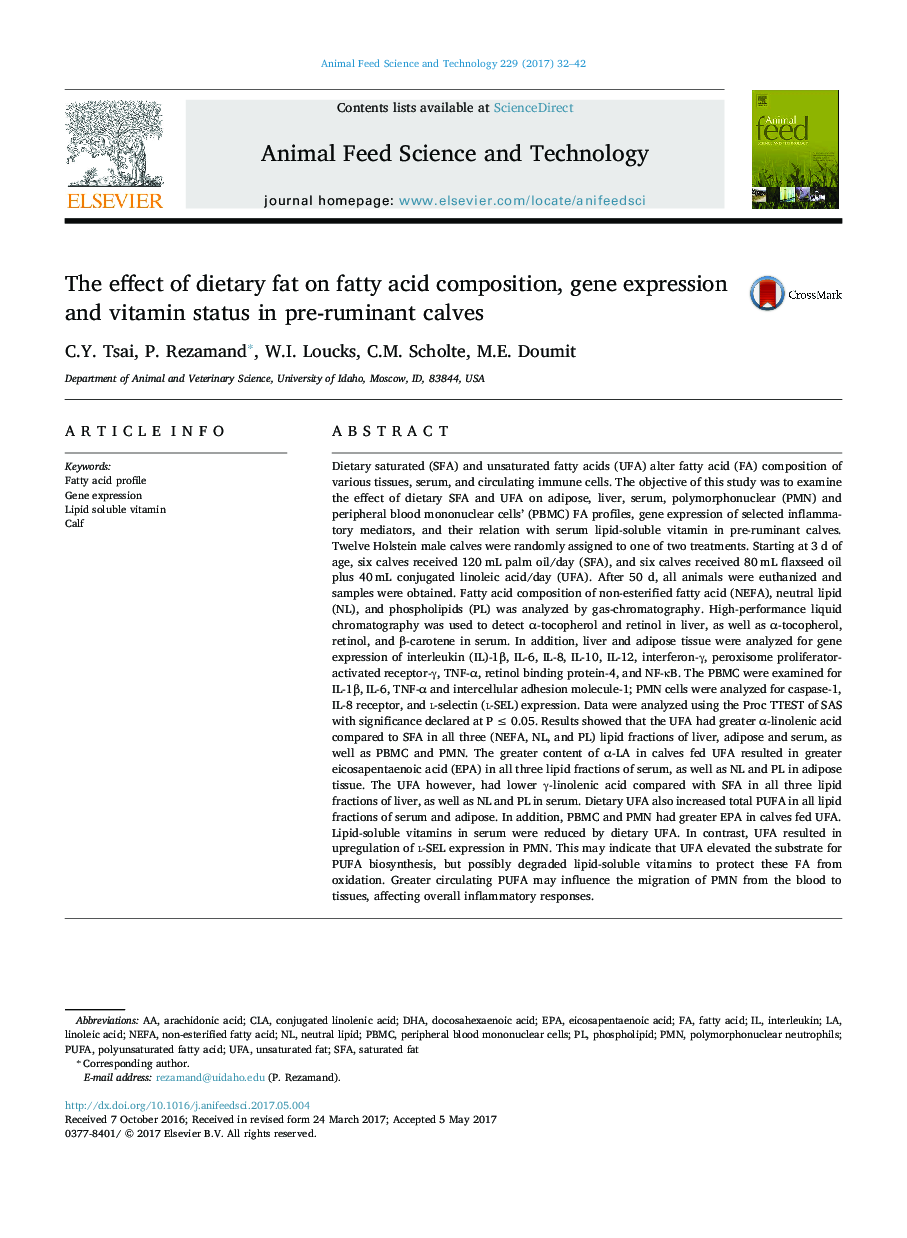| Article ID | Journal | Published Year | Pages | File Type |
|---|---|---|---|---|
| 5538847 | Animal Feed Science and Technology | 2017 | 11 Pages |
Abstract
Dietary saturated (SFA) and unsaturated fatty acids (UFA) alter fatty acid (FA) composition of various tissues, serum, and circulating immune cells. The objective of this study was to examine the effect of dietary SFA and UFA on adipose, liver, serum, polymorphonuclear (PMN) and peripheral blood mononuclear cells' (PBMC) FA profiles, gene expression of selected inflammatory mediators, and their relation with serum lipid-soluble vitamin in pre-ruminant calves. Twelve Holstein male calves were randomly assigned to one of two treatments. Starting at 3 d of age, six calves received 120 mL palm oil/day (SFA), and six calves received 80 mL flaxseed oil plus 40 mL conjugated linoleic acid/day (UFA). After 50 d, all animals were euthanized and samples were obtained. Fatty acid composition of non-esterified fatty acid (NEFA), neutral lipid (NL), and phospholipids (PL) was analyzed by gas-chromatography. High-performance liquid chromatography was used to detect α-tocopherol and retinol in liver, as well as α-tocopherol, retinol, and β-carotene in serum. In addition, liver and adipose tissue were analyzed for gene expression of interleukin (IL)-1β, IL-6, IL-8, IL-10, IL-12, interferon-γ, peroxisome proliferator-activated receptor-γ, TNF-α, retinol binding protein-4, and NF-κB. The PBMC were examined for IL-1β, IL-6, TNF-α and intercellular adhesion molecule-1; PMN cells were analyzed for caspase-1, IL-8 receptor, and l-selectin (l-SEL) expression. Data were analyzed using the Proc TTEST of SAS with significance declared at P â¤Â 0.05. Results showed that the UFA had greater α-linolenic acid compared to SFA in all three (NEFA, NL, and PL) lipid fractions of liver, adipose and serum, as well as PBMC and PMN. The greater content of α-LA in calves fed UFA resulted in greater eicosapentaenoic acid (EPA) in all three lipid fractions of serum, as well as NL and PL in adipose tissue. The UFA however, had lower γ-linolenic acid compared with SFA in all three lipid fractions of liver, as well as NL and PL in serum. Dietary UFA also increased total PUFA in all lipid fractions of serum and adipose. In addition, PBMC and PMN had greater EPA in calves fed UFA. Lipid-soluble vitamins in serum were reduced by dietary UFA. In contrast, UFA resulted in upregulation of l-SEL expression in PMN. This may indicate that UFA elevated the substrate for PUFA biosynthesis, but possibly degraded lipid-soluble vitamins to protect these FA from oxidation. Greater circulating PUFA may influence the migration of PMN from the blood to tissues, affecting overall inflammatory responses.
Keywords
UFAPMNSFACLANEFAPBMCEPAArachidonic acidEicosapentaenoic aciddocosahexaenoic acidconjugated linolenic acidLinoleic acidFatty acidNon-esterified fatty acidPolyunsaturated fatty acidPUFAinterleukinGene expressionDHAperipheral blood mononuclear cellsPhospholipidneutral lipidFatty acid profilePolymorphonuclear neutrophilsUnsaturated fatsaturated fatCalf
Related Topics
Life Sciences
Agricultural and Biological Sciences
Animal Science and Zoology
Authors
C.Y. Tsai, P. Rezamand, W.I. Loucks, C.M. Scholte, M.E. Doumit,
